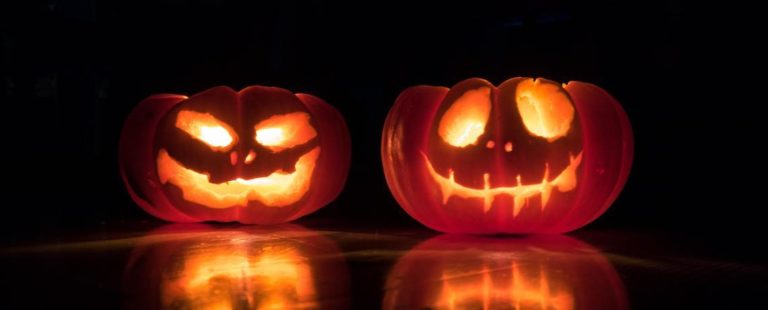While retailers won’t see the same record-high spending this year on Halloween, experts still predict a strong season. See how Halloween shopping continues to evolve over the years, and why online shopping continues to trend up in 2020.
Total Spending for Halloween
With social distancing encouraged this year, more than 148 million U.S. adults plan to participate in Halloween-related activities like dressing up, passing out candy, and decorating their homes. However, overall participation is slightly down at 58%.
With fewer participants, NRF also predicts overall consumer spending to reach $8.05 billion, down slightly from $8.78 billion in 2019.
However, those who are participating will spend more on average. NRF predicts them to spend on average $92.12, up from $86.27 in 2019. [NRF: Consumers Anticipate New Ways to Celebrate Halloween, Despite COVID-19]
Top-Selling Halloween Products
As consumers shop for Halloween, they plan to purchase the following in 2020: 96% candy, 65% costumes, 75% decorations, 40% greeting cards. [NRF Halloween Data Center]
Pet Costumes Continue to Increase
Another category to watch is the rise in consumers buying costumes for their pets. In 2010, just 12% planned to dress up their pets. Today, it’s nearly 2 in 10 (17%). Last year, that added up to $490 million total spending on pet costumes, more than double in 2010. [NRF: Halloween shopping trends: Then and now]
Top Places to Shop for Halloween
When looking to buy for Halloween, consumers plan on shopping at these top four places: Discount stores 38%, specialty stores 32%, online 29%, and grocery stores 26%. [NRF: Halloween Data Center]
How Halloween Pop-up Stores will Fare in 2020
One thing that looks different in 2020 is the availability of Halloween-themed stores.
Disrupted by the pandemic, Party City plans to open just 25 pop-up stores under its Halloween City name this year — a 91% reduction compared to last year’s 275 Halloween pop-ups. [Retail Dive]
Spirit Halloween on the other hand has opened 1,400 storefronts nationwide, more than last year. They’re taking advantage of empty and cheaper real estate for their temporary leases. [The New York Times]
Halloween Shifts to Online
Retail analysts like Katie Thomas though aren’t sure if the pop-up strategy will bring in the same sales as years past for stores like Spirit Halloween. She foresees customers wanting to “streamline their shopping trips to a single destination” and focusing on buying home decor over costumes.
And, Party City executives echoed the same thoughts last year. They saw a deep decline in October sales in 2019, before the pandemic. They cited the loss of market share to a surprising shift to online shopping and the desire for consumers to consolidate trips.
Beyond purchasing, online search is also the top source of Halloween inspiration.
When looking for inspiration:
- 35% start with online search
- 28% browse stores
- 20% get ideas from friends and family
More importantly, social media’s influence has increased significantly since 2015, with Pinterest at the top. [NRF: Social media influencing near-record Halloween spending]
Lastly, it still remains to be seen what Amazon Prime Day in October could do for Halloween online sales this year. Prime Day did include sales on costumes, candy, and decor.
How to Win Halloween Online
For last minute prep for this year and 2021 planning, here’s a few ways online sellers can continue to grab Halloween sales:
1. Focus on Growing Demographics
Halloween is no longer just a fun holiday for children.
This year 18-24 year olds are the most likely to celebrate Halloween, with nearly nine in 10 planning to do so, up from 84% a decade ago. [NRF: Halloween shopping trends: Then and now]
This rising demographic has different shopping habits (read: online) than their older counterparts that you can take advantage of.
2. Ramp up Social Media
Experts suggest that there’s an increase in consumers whose Halloween purchases are inspired by their friends, neighbors, and even celebrities on social media. Platforms like Pinterest, YouTube, Instagram, and Facebook can be used to encourage purchases.
Consider using “buy buttons” to make it easy and simple for users to be both inspired and buy on social media platforms.
3. Use Email Marketing to Your Advantage
Email marketing is one of the best tools to encourage more purchases online. Just like for Amazon Prime Day, businesses can deliver strong email experiences to get a lift in sales during these shopping periods.
4. Start Promotions Early
Today’s shoppers start making Halloween purchases way before the last day in October. Start your email and online promotions early to take advantage of early shoppers.
According to NRF, around 30% of shoppers start in September while more than 40% start during the first two weeks of October.
5. Offer Fast Shipping
Many customers turn to in-person shopping to avoid shipping times and costs. If you’re an online seller, be sure to offer competitive shipping times and rates to not deter from online purchases.
Halloween Kicks Off Holiday Shopping
While overall spending is down in 2020, retailers still expect a strong Halloween season. And, that’s a good thing because Halloween weekend is what kicks off holiday shopping.
To keep up with more holiday shopping trends, subscribe to the Payability newsletter to get insights like these right in your inbox.
Sources and Citation Info:
To be clear, none of the statistics above are based on research by Payability. This post is a compilation of statistics from various web sources that are cited throughout the article. We hope to give you one, convenient place to find data about Halloween shopping trends.
For any formal or academic purposes, please cite the original source of the data.


